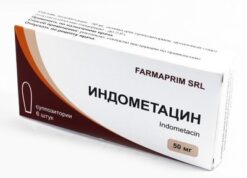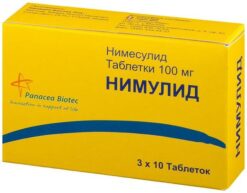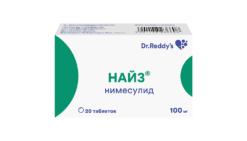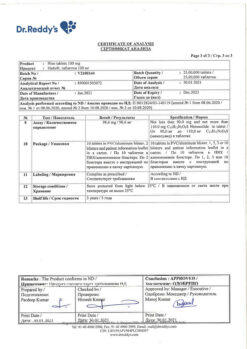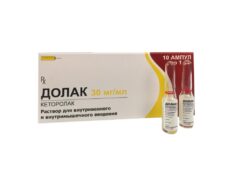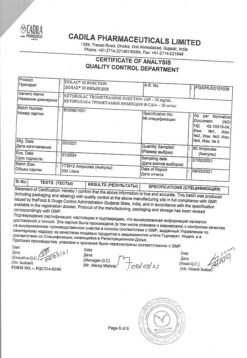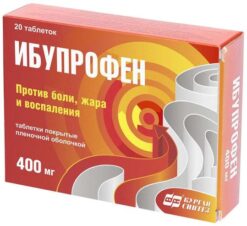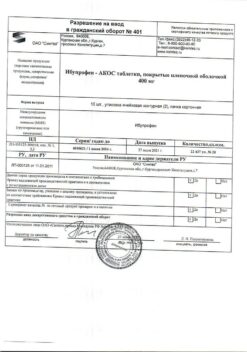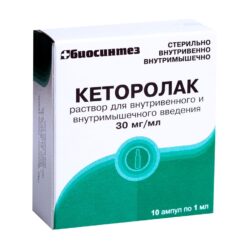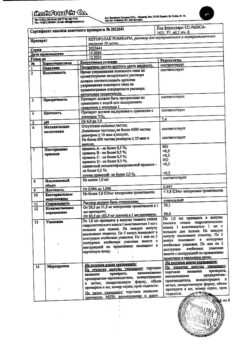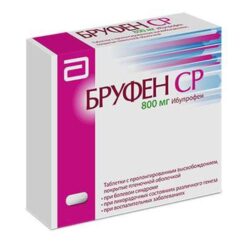No products in the cart.
Brustan, 1000 mg 10 pcs
€9.27 €7.73
Description
Pharmacotherapeutic group
Non-steroidal anti-inflammatory drug (NSAID) and analgesic non-narcotic.
The ATC code: M01AE51.
Pharmacological properties
A combination drug. It has analgesic, anti-inflammatory and antipyretic effects. The mechanism of anti-inflammatory action of ibuprofen is due to inhibition of cyclogenase (COX) activity with subsequent inhibition of prostaglandin synthesis.
Paracetamol is a non-narcotic analgesic which blocks COX mainly in CNS, affecting centers of pain and thermoregulation, has analgesic and antipyretic effect.
Pharmacokinetics
Ibuprofen is well absorbed from the stomach. Tmax is about 1 hour. Absorption is slightly reduced when the drug is taken after a meal. About 99% is bound to plasma proteins. Ibuprofen is slowly distributed in synovial fluid and is eliminated from it more slowly than from plasma. It is metabolized in the liver, mainly through hydroxylation and carboxylation of isobutyl group. CYP2C9 isoenzyme is involved in metabolism of the drug. After absorption about 60% of pharmacologically inactive R-form of ibuprofen is slowly transformed into active S-form. It has biphasic elimination kinetics. The plasma elimination half-life (T ? ) is 2-3 hours. Up to 90% of the dose can be detected in the urine as metabolites and their conjugates. Less than 1% is excreted unchanged in the urine and, to a lesser extent, in the bile. Ibuprofen is completely eliminated within 24 hours.
Paracetamol is quickly absorbed from the gastrointestinal tract. Time to reach C max in 0.5-2 hours. It is evenly distributed in body fluids. Binding to plasma proteins is variable within 15%. It penetrates through the BBB. It is metabolized in liver (90-95%): 80% enters into conjugation reactions with glucuronic acid and sulfates to form inactive metabolites; 17% undergoes hydroxylation to form 8 active metabolites, which when conjugated with glutathione form inactive metabolites. In case of glutathione deficiency these metabolites can block enzyme systems of hepatocytes and cause their necrosis. The CYP2E1 isoenzyme is involved in the metabolism of paracetamol. T 1/2 1-4 hours. It is excreted by the kidneys as conjugates and only 3% unchanged. In elderly patients, paracetamol clearance is decreased and T1/2 is increased.
Indications
Indications
For adults:
pain of moderate intensity due to injuries (bruises, sprains, dislocations, fractures);
postoperative period;
algodismenorrhea;
toothache;
neuralgia;
myalgia;
lumbago;
fibrositis;
tenosynovitis;
rheumatoid arthritis;
osteoarthritis;
ankylosing spondylitis;
sinusitis;
tonsillitis;
headache;
fever.
For children (as an aid): tonsillitis; acute infectious and inflammatory diseases of the upper respiratory tract.
Pharmacological effect
Pharmacological effect
Pharmacotherapeutic group
non-steroidal anti-inflammatory drug (NSAID) and non-narcotic analgesic.
ATX code: M01AE51.
Pharmacological properties
Combined drug. It has analgesic, anti-inflammatory and antipyretic effects. The mechanism of the anti-inflammatory effect of ibuprofen is due to inhibition of the activity of cyclogenases (COX) with subsequent suppression of prostaglandin synthesis.
Paracetamol is a non-narcotic analgesic that blocks COX mainly in the central nervous system, affecting the centers of pain and thermoregulation, and has an analgesic and antipyretic effect.
Pharmacokinetics
Ibuprofen is well absorbed from the stomach. Tmax – about 1 hour. Absorption is slightly reduced when taking the drug after meals. About 99% binds to plasma proteins. Ibuprofen is slowly distributed in and cleared from synovial fluid more slowly than from plasma. It is metabolized in the liver, mainly by hydroxylation and carboxylation of the isobutyl group. The CYP2C9 isoenzyme takes part in the metabolism of the drug. After absorption, approximately 60% of the pharmacologically inactive R form of ibuprofen is slowly transformed into the active S form. Has two-phase elimination kinetics. The half-life (T ? ) from plasma is 2-3 hours. Up to 90% of the dose can be found in urine in the form of metabolites and their conjugates. Less than 1% is excreted unchanged in urine and, to a lesser extent, in bile. Ibuprofen is completely eliminated within 24 hours.
Paracetamol is rapidly absorbed from the gastrointestinal tract. Time to reach Cmax in 0.5-2 hours. Evenly distributed in body fluids. The binding to plasma proteins is variable within 15%. Penetrates through the BBB. Metabolized in the liver (90-95%): 80% enters into conjugation reactions with glucuronic acid and sulfates to form inactive metabolites; 17% undergoes hydroxylation to form 8 active metabolites, which, when conjugated with glutathione, form inactive metabolites. With a lack of glutathione, these metabolites can block the enzyme systems of hepatocytes and cause their necrosis. The CYP2E1 isoenzyme is involved in the metabolism of paracetamol. T 1/2 1-4 hours. It is excreted by the kidneys in the form of conjugates, and only 3% unchanged. In elderly patients, paracetamol clearance decreases and T1/2 increases.
Special instructions
Special instructions
Treatment with the drug should be carried out in the minimum effective dose, in the shortest possible short course.
During treatment, monitoring of the peripheral blood picture and the functional state of the liver and kidneys is necessary.
When symptoms of gastropathy appear, careful monitoring is indicated, including esophagogastroduodenoscopy, a blood test to determine hemoglobin, hematocrit, and a stool test for occult blood.
To prevent the development of NSAID gastropathy, it is recommended to combine it with prostaglandin E drugs (misoprostol). Patients should refrain from all activities that require increased attention, rapid mental and motor reactions. During the treatment period, drinking alcohol (ethanol) is not recommended.
When taken simultaneously with indirect anticoagulants, it is necessary to monitor the blood coagulation system.
Active ingredient
Active ingredient
Ibuprofen, Paracetamol
Composition
Composition
Each tablet contains:
Contraindications
Contraindications
Hypersensitivity to ibuprofen, paracetamol, acetylsalicylic acid or other NSAIDs, as well as to other components of the drug;
A history of an attack of bronchial obstruction, urticaria, rhinitis, provoked by taking acetylsalicylic acid (salicylates) or other NSAIDs (complete or incomplete acetylsalicylic acid intolerance syndrome: rhinosinusitis, urticaria, polyps of the nasal mucosa, bronchial asthma).
The period after coronary artery bypass surgery
Erosive and ulcerative lesions of the gastrointestinal tract, active gastric bleeding
Inflammatory bowel diseases
Hypocoagulable state, cerebrovascular bleeding
Severe renal and/or liver failure, confirmed hyperkalemia;
Pregnancy III trimester, lactation period;
Children under 12 years of age (this dosage form)
With caution: congestive heart failure, arterial hypertension, coronary heart disease, cerebrovascular diseases, dyslipidemia, diabetes mellitus, peripheral arterial disease, smoking, frequent alcohol consumption, hyperbilirubinemia, liver cirrhosis with portal hypertension, liver and/or renal failure, nephrotic syndrome, pregnancy I and II trimesters, old age, deficiency glucose-6-phosphate dehydrogenase, peptic ulcer of the stomach and duodenum (history), gastritis, blood diseases of unknown etiology (leukopenia and anemia).
Side Effects
Side Effects
When using the drug, side effects are rare, but the following side effects may occur:
Gastrointestinal tract: NSAID gastropathy (nausea, vomiting, heartburn, abdominal pain, constipation, flatulence, loss of appetite, rarely – ulceration of the gastrointestinal mucosa, in some cases complicated by bleeding and perforation), irritation or dryness of the oral mucosa, pain in the mouth, ulceration of the gum mucosa,
Hepato-biliary system: hepatitis
Allergic reactions: skin rash (usually erythematous or urticaria), skin itching, angioedema, anaphylactoid reactions, anaphylactic shock, bronchospasm or dyspnea, fever, erythema multiforme exudative (including Stevens-Johnson syndrome), toxic epidermal necrolysis (Lyell’s syndrome), eosinophilia, allergic rhinitis.
Cardiovascular system: heart failure, tachycardia, increased blood pressure.
Central and peripheral nervous system: headache, dizziness, insomnia, anxiety, nervousness and irritability, psychomotor agitation, drowsiness, depression, confusion, hallucinations, rarely – aseptic meningitis (more often in patients with autoimmune diseases)
Hematopoietic organs: anemia (including hemolytic, aplastic), thrombocytopenia and thrombocytopenic purpura, agranulocytosis, leukopenia.
Respiratory system: shortness of breath, bronchospasm.
Sense organs: hearing impairment (ringing or noise in the ears), visual impairment (toxic optic neuritis, blurred vision or diplopia, dryness and irritation of the eyes, swelling of the conjunctiva and eyelids of allergic origin, scotoma)
Urinary system: acute renal failure, allergic nephritis, nephrotic syndrome (edema), polyuria, cystitis
Laboratory parameters: bleeding time, serum creatinine concentration, liver transaminase activity (may increase); serum glucose concentration, creatinine clearance, hemotocrit, or hemoglobin (may decrease).
Interaction
Interaction
Inducers of microsomal oxidation (phenytoin, ethanol, barbiturates, rifampicin, phenylbutazone, tricyclic antidepressants) increase the production of hydroxylated active metabolites, increasing the risk of severe hepatotoxic reactions.
Overdose
Overdose
Problems with overdose occur very rarely, however, in case of accidental overdose, you should immediately consult a doctor.
Storage conditions
Storage conditions
Store in a dry place, protected from light, at a temperature not exceeding 25°C. Keep out of the reach of children.
Shelf life
Shelf life
3 years.
Manufacturer
Manufacturer
Sun Pharmaceutical Industries Ltd, India
Additional information
| Shelf life | 3 years. |
|---|---|
| Conditions of storage | Store in a dry, light-protected place at a temperature not exceeding 25°C. Keep out of reach of children. |
| Manufacturer | Sun Pharmaceutical Industries Ltd, India |
| Medication form | pills |
| Brand | Sun Pharmaceutical Industries Ltd |
Related products
Buy Brustan, 1000 mg 10 pcs with delivery to USA, UK, Europe and over 120 other countries.


